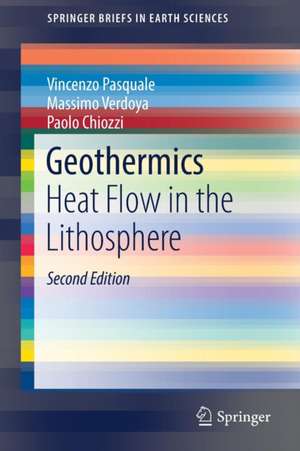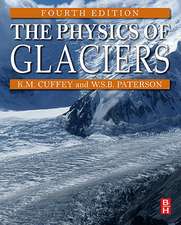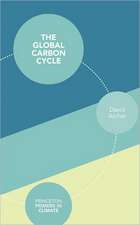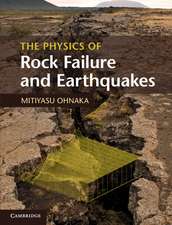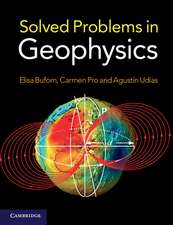Geothermics: Heat Flow in the Lithosphere: SpringerBriefs in Earth Sciences
Autor Vincenzo Pasquale, Massimo Verdoya, Paolo Chiozzien Limba Engleză Paperback – 10 feb 2017
This book, now in its second edition, offers a comprehensive and modern treatment on the background knowledge of heat transfer processes in the lithosphere. In the light of the success of the first edition, several chapters of the book have been revised and the book has been enriched with a new chapter on geothermal methods used for the inference of past climate changes.
The book starts with a brief review of global tectonics and of the structure of the crust and upper mantle. Then the theory of heat conduction as well as the thermal properties and the methods for the determination of thermal conductivity and radiogenic heat are introduced. Subsequently the geothermal flow and the thermal state of the lithosphere and deep interior are analyzed. The formation, upwelling mechanisms, solidification and cooling of magmas, which can be a fundamental heat source in many geothermal systems, are reviewed. Analytical methods used for gaining information on heat and groundwater flow from the analyses of temperature depth data are also covered. Data and practical examples are supplied to facilitate the understanding of the different topics.
The book is intended for Earth science graduate students and researchers.
| Toate formatele și edițiile | Preț | Express |
|---|---|---|
| Paperback (2) | 351.90 lei 38-44 zile | |
| Springer International Publishing – 13 noi 2013 | 351.90 lei 38-44 zile | |
| Springer International Publishing – 10 feb 2017 | 446.26 lei 6-8 săpt. |
Din seria SpringerBriefs in Earth Sciences
-
 Preț: 380.25 lei
Preț: 380.25 lei -
 Preț: 378.12 lei
Preț: 378.12 lei -
 Preț: 290.09 lei
Preț: 290.09 lei -
 Preț: 477.72 lei
Preț: 477.72 lei -
 Preț: 381.98 lei
Preț: 381.98 lei -
 Preț: 355.07 lei
Preț: 355.07 lei -
 Preț: 355.37 lei
Preț: 355.37 lei -
 Preț: 351.90 lei
Preț: 351.90 lei -
 Preț: 381.21 lei
Preț: 381.21 lei -
 Preț: 377.35 lei
Preț: 377.35 lei -
 Preț: 342.44 lei
Preț: 342.44 lei -
 Preț: 343.98 lei
Preț: 343.98 lei - 20%
 Preț: 389.08 lei
Preț: 389.08 lei -
 Preț: 378.92 lei
Preț: 378.92 lei -
 Preț: 375.62 lei
Preț: 375.62 lei -
 Preț: 379.68 lei
Preț: 379.68 lei -
 Preț: 378.12 lei
Preț: 378.12 lei -
 Preț: 377.18 lei
Preț: 377.18 lei -
 Preț: 443.75 lei
Preț: 443.75 lei -
 Preț: 378.54 lei
Preț: 378.54 lei -
 Preț: 380.07 lei
Preț: 380.07 lei -
 Preț: 376.96 lei
Preț: 376.96 lei -
 Preț: 379.09 lei
Preț: 379.09 lei - 15%
 Preț: 464.18 lei
Preț: 464.18 lei -
 Preț: 376.96 lei
Preț: 376.96 lei -
 Preț: 348.01 lei
Preț: 348.01 lei -
 Preț: 379.48 lei
Preț: 379.48 lei -
 Preț: 375.07 lei
Preț: 375.07 lei -
 Preț: 477.94 lei
Preț: 477.94 lei -
 Preț: 376.22 lei
Preț: 376.22 lei -
 Preț: 349.41 lei
Preț: 349.41 lei -
 Preț: 381.00 lei
Preț: 381.00 lei - 15%
 Preț: 463.35 lei
Preț: 463.35 lei -
 Preț: 376.22 lei
Preț: 376.22 lei -
 Preț: 376.96 lei
Preț: 376.96 lei -
 Preț: 446.47 lei
Preț: 446.47 lei -
 Preț: 346.62 lei
Preț: 346.62 lei -
 Preț: 379.68 lei
Preț: 379.68 lei -
 Preț: 373.32 lei
Preț: 373.32 lei -
 Preț: 377.95 lei
Preț: 377.95 lei -
 Preț: 377.57 lei
Preț: 377.57 lei -
 Preț: 390.83 lei
Preț: 390.83 lei -
 Preț: 375.45 lei
Preț: 375.45 lei -
 Preț: 377.73 lei
Preț: 377.73 lei -
 Preț: 376.04 lei
Preț: 376.04 lei -
 Preț: 377.18 lei
Preț: 377.18 lei -
 Preț: 379.09 lei
Preț: 379.09 lei
Preț: 446.26 lei
Nou
Puncte Express: 669
Preț estimativ în valută:
85.39€ • 93.05$ • 71.96£
85.39€ • 93.05$ • 71.96£
Carte tipărită la comandă
Livrare economică 23 aprilie-07 mai
Preluare comenzi: 021 569.72.76
Specificații
ISBN-13: 9783319520834
ISBN-10: 3319520830
Pagini: 138
Ilustrații: XI, 138 p. 60 illus.
Dimensiuni: 155 x 235 x 8 mm
Greutate: 0.22 kg
Ediția:2nd ed. 2017
Editura: Springer International Publishing
Colecția Springer
Seria SpringerBriefs in Earth Sciences
Locul publicării:Cham, Switzerland
ISBN-10: 3319520830
Pagini: 138
Ilustrații: XI, 138 p. 60 illus.
Dimensiuni: 155 x 235 x 8 mm
Greutate: 0.22 kg
Ediția:2nd ed. 2017
Editura: Springer International Publishing
Colecția Springer
Seria SpringerBriefs in Earth Sciences
Locul publicării:Cham, Switzerland
Cuprins
1. Lithosphere Structure and Dynamics.- 2. Heat Conduction and Thermal Parameters.- 3. Thermal State.- 4. Temperature and Magmatic Processes.- 5. Heat in the Groundwater Flow.- 6. Underground Temperatures and Climate Changes.
Recenzii
“It is … particularly useful for anyone with a specific interest in geothermics, who does not want to delve into a more comprehensive geophysics book, such as Turcotte and Schubert’s Geodynamics. The book is suitable for students of Earth Sciences, at the senior undergraduate level or beyond, who are comfortable with a mathematical development of the topic.” (Duncan Woodcock, Proceedings of the Open University Geological Society, Vol. 6, 2020)
Notă biografică
Vincenzo Pasquale worked as a Researcher for the National Research Council (CNR) from 1972 to 1979 and as Assistant Professor of Physics of the Earth for the Geodetic and Geophysical Institute of the University of Genoa, Italy. Since 1980, he is a Professor of Solid Earth Geophysics at the University of Genoa. He has authored more than 250 scientific papers, 100 of which were published in leading international journals. The first ten years of his research were devoted mainly to seismology. In 1980s, he began his studies on the Earth’s rheology and thermal field. He has been responsible of a numerous research projects. He is a member of national and international scientific associations and referee of international journals.
Massimo Verdoya received his MSc in Geological Sciences in 1985, and in 1992 his Ph.D. degree in Geophysics at the University of Genoa, Italy. From 1993 to 2014 he worked as a Researcher in Solid Earth Geophysics and thereafter as Associate Professor at the University of Genoa. His fields of interest are: thermal modeling of lithospheric geodynamical processes, applied geothermics, analytical and numerical simulations of heat and groundwater transfer (with special reference to hydrothermal reservoirs), determinations of thermo-physical properties of rocks and soils (thermal conductivity and diffusivity), past climate change inferred from underground temperatures. He is vice-chairman of the International Heat Flow Commission of the IASPEI (International Association of Seismology and Physics of the Earth Interior) and member of the board of directors of the International Geothermal Association.
Paolo Chiozzi received his MSc in Earth Sciences in 1989 and his Ph.D. in Geophysics at the University of Genoa (Italy) in 1995. Since 1996, he works as a Research Fellow at the University of Genoa on several projects encompassing a wide range of geodynamic and geothermic problems. Hisresearch is focused on the relationships between the thermal structure and the deformation processes within the lithosphere. He has developed techniques of spectral analysis of magnetic data to obtain information on the deep magnetic boundary and their relation with the temperature distribution and the Curie point. Moreover, his activity is addressed to the determination of thermo-physical properties and natural radioactivity of rocks and soils and underground temperatures. He has published more than 50 papers in international journals.
Caracteristici
Includes supplementary material: sn.pub/extras
Textul de pe ultima copertă
After a brief review of global tectonics and the structure of the crust and upper mantle, the basic relations of conductive heat transport and the rock thermal properties are introduced as well as the various methods for measuring thermal conductivity and heat generation due to the decay of radioactive elements. The authors analyze geothermal flow and the thermal state of the lithosphere and deep interior and discuss the fundamental problems related to the formation, upwelling mechanisms, solidification and cooling of magmas. The text presents analytical methods that allow us to gain information on heat and groundwater flow from the analyses of temperature–depth data. It also provides ample data and examples to facilitate understanding of the different topics.
This book is useful to researchers and graduate students interested in pure and applied geothermics.
This book is useful to researchers and graduate students interested in pure and applied geothermics.
